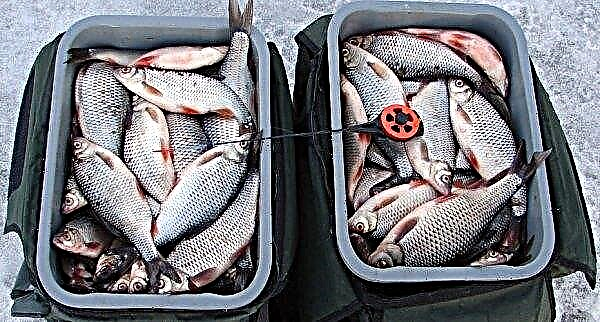Blueberries are a fairly new crop in our country, the secrets of growing which even experienced gardeners may not know. The article discusses methods of reproduction and further care of the plant.
Layering
This method has pros and cons. The positive side can be attributed to the fact that young bushes that do not have time to shoot a lot of shoots are suitable for propagation, the negative - a time-consuming process that requires a lot of time. The procedure is carried out in the summer when the shoots are in an active phase of growth.

First you need to prepare the soil around the bush. Loosening will be enough. Choose the most powerful shoots and lay on the ground. In the ground it is necessary to make small grooves (about 7 cm deep). The length of the fossa depends on the size of the shoot. The shoot is put in a hole and covered with sawdust.
So that the shoot does not rise and does not stretch up, it can be fixed with wire by sticking it in the ground. It is better to install wire in the area of developed kidneys.
It is necessary to fill up the hole with sawdust and pour plenty of water. After a couple of years, the cuttings will take root, and they can be transplanted to a new place, separated from the main bush.
Video: Blueberry propagation by layering
Cuttings
Propagating blueberries is easier with cuttings than layering. Cuttings are carried out using green and lignified shoots. Consider each method in more detail.
Green
The optimal period for the procedure is the end of June - the beginning of July. Suitable shoots should be green and have springy stems. To cut the cuttings, you need to choose the most powerful shoots (6-12 cm). You can break them off manually.
Did you know? Blueberries are able to regulate blood sugar after its use. That is why doctors recommend it to diabetics.
Preparing the cuttings involves the following steps:
- on the lower part of the handle it is necessary to remove the exfoliated bark;
- leaves are also removed from the bottom;
- the stalk should be treated with any growth stimulator.

Lignified
Propagating blueberries with woody shoots is easier. Cutting period - early spring. It is necessary to choose last year's shoots with a diameter of 0.5-1.2 cm. If you select shoots thicker, such cuttings can be poorly rooted. Shoots with a lot of kidneys are not suitable. When grafting, part of the kidneys will need to be removed, and this can adversely affect the result of reproduction.
Branches must be cut in the winter. Then they are kept until spring in a cool room in a container with sawdust and peat.
Important! On one handle should be at least 3 vegetative buds.
Features of cutting lignified cuttings:
- cut into a length of 10-12 cm;
- the lower cut must be done with a slight bias under the kidney;
- a cut in the upper part is carried out above the kidney (1 cm higher);
- cuttings need to be treated with a growth stimulator.

Rooting cuttings
Rooting cuttings occurs in greenhouse conditions. You can place them in beds or special containers with a height of at least 15 cm. It is better to root cuttings in a substrate of peat and river sand. A couple of days before planting, the substrate must be sieved and watered. Blueberries need drainage, so be sure to make it in the seat.
After planting cuttings in the room, it is necessary to maintain a temperature of +20 ... + 25 ° С. It is important that the substrate does not dry out, but it is also impossible to fill it with water. After a month, you will see that the root system begins to form in the cuttings.
3 months after planting, the greenhouse can be dismantled, the plant is left in the open air. Before winter, the soil is mulched with fallen leaves, sawdust and peat. In spring, you can change to a permanent place.
 Place the cuttings in a seat so that 2 buds remain on the surface
Place the cuttings in a seat so that 2 buds remain on the surface
Blueberries are also bred with the help of a berry seed. But this method is time consuming and requires a lot of time and effort. It is used very rarely.
Blueberry grafting
Cultivation is also possible with vaccination. In large nurseries, this method of reproduction is practically not used for this crop. It is more suitable for home use.
The main branches of blueberries do not tend to grow from the trunk, but, as a rule, begin to grow at the base of the bush, closer to the soil. This plant structure is not very suitable for vaccination. Therefore, it is better to choose bushes, the main branches of which begin to grow from the trunk away from the soil level.
The vaccination algorithm is as follows:
- Plant material is selected in December. For this, lignified shoots 1 year old are suitable. They must be stored in a cold room until vaccination begins.
- In January, on the plant to be grafted, it is necessary to select 8 shoots and cut them manually (50 cm high). Coat all sections with special oil.
- Immediately after trimming, the cut branches are crushed (each segment is not more than 20 cm).
- In mid-March, you can start vaccination. This is done by the splitting method.

Further care
Blueberry is an undemanding plant, it is easy to care for it. The following are highlights on crop care.
Watering
Drying of the soil harms blueberries, so you will have to water the plant often. For watering, it is better to use a watering can. She will not wash the mulch, which must be near the trunk of the plant. The optimal indicator of soil moisture is 60–70%. To maintain this humidity should be abundantly watered bush 2 times a week in the evening. In July-August, the number of irrigations can be increased up to 3 times. This will improve yield and help form flower buds for next year.
 Despite the fact that blueberries are a moisture-loving plant, it does not tolerate stagnation of water, so be sure to drain in the pit during planting
Despite the fact that blueberries are a moisture-loving plant, it does not tolerate stagnation of water, so be sure to drain in the pit during planting
In times of drought and heat, shrubs can be sprayed with water in the evening. In this way, you will help the plant avoid the stress that it can get during high temperatures.
Top dressing
Blueberries do not respond well to organic fertilizers such as green manure, manure and compost. The only thing that suits her is sour horse peat or half-ripened coniferous litter. It is better to use mineral fertilizers to nourish the crop.. It is necessary to start feeding bushes 3 years after planting.
Mineral fertilizers for blueberries:
- Nitrogen. Stimulates shoot growth and fruit formation. It is enough to bring 60 g per year under the bush
- Phosphorus. Affects yield and disease resistance. 50 g per year is enough for one bush
- Potassium. Helps the plant resist disease. With fertilizer, the bushes more easily tolerate winter and drought. In a year, one bush is enough to get 40 g of the substance.
Blueberry Fertilizer Plan:
- In early springwhen the plant is just starting to wake up, it is necessary to make nitrogen fertilizers under the bush.
- During budding blueberries can be sprayed with a growth stimulant.
- During the formation of berries bushes can be fed with complex fertilizers.
- In August it will be useful for the plant to receive potassium-phosphorus fertilizer recharge.

Mulching
Mulching is a must in caring for blueberry bushes. The procedure can be performed using:
- sawdust;
- straw;
- coniferous bark;
- leaves;
- needles.
 Despite the fact that with a layer of mulch in the spring, the buds bloom later, for the plant it is only better. Thus, early frosts will not harm the future crop
Despite the fact that with a layer of mulch in the spring, the buds bloom later, for the plant it is only better. Thus, early frosts will not harm the future crop
The optimal layer of mulch should be up to 15 cm. The procedure will help not only maintain moisture in the soil, but also prevent the growth of weeds. Mulching also protects the root system of the plant from low temperatures in the winter.
Important! As a result of mulching with fresh sawdust, the plant increases the consumption of nitrogen from the soil, so in spring, when mulching, additionally nourish blueberries with nitrogen fertilizers.
Pruning
Trimming and bush formation should be started from the third year after planting. Systematically remove weak, damaged and diseased shoots. It is better to prune in the spring before the buds open. If you carry out the procedure in the fall, then the cutoff site may suffer from severe frosts in winter.
During the annual pruning period, consider the following:
- Young bushes need to be trimmed more. This procedure stimulates plant growth.
- Only upright growth should be kept, and low sprawling ones should be cut off. At least 5 annual shoots should remain on the shrub.
- On fruiting bushes, which are more than 5 years old, shoots older than 4 years should prevail.
- With a very dense crown, you can cut the inner old and weak branches.
- Remove small and thin branches. Leave only strong shoots and skeletal branches.
- After pruning, do not leave cut branches near the bush. It’s better to burn them the same day. This way you prevent infections from developing on them.

In many ways, pruning depends on the variety of blueberries:
- in bushes with wide crowns, cut off the entire top of the plant;
- in bushes with a more elongated shape, it is necessary to prune the strongest shoots to stimulate their growth;
- in bushes with a dense and dense crown, the most branched shoots are shortened;
- the most fruitful varieties of blueberries with a large number of branches need to thin out the bush well every year.
Did you know? The amount of antioxidants in blueberries exceeds this indicator in any vegetables or fruits.
Breeding blueberries does not always give the desired result. The survival rate of the plant is low. But if you follow all the tips given in the article, the culture will be healthy and strong, and numerous berries will be able to please you for a long time on the garden plot and on the table.












